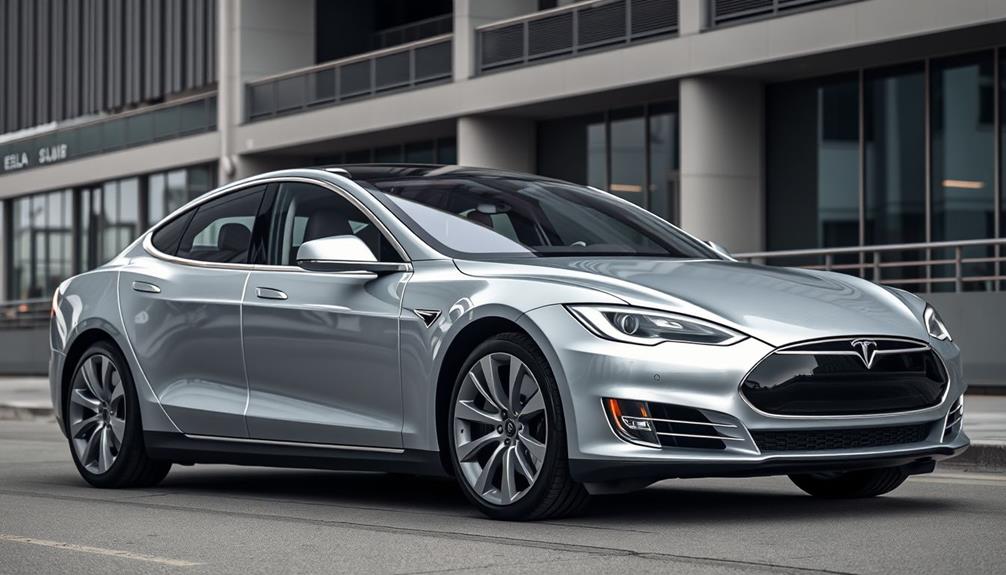Tesla Superchargers aren't free; you'll pay varying costs based on local electricity rates and additional fees. On average, it costs about $27 to fully charge your vehicle, with rates ranging from $0.11 to $0.60 per kWh. You might face idle and congestion fees if you don't unplug promptly after charging or if the station is busy. While some businesses offer free charging, those opportunities are limited. Charging at home is typically cheaper. So, if you want to know more about strategies to manage these costs effectively, keep exploring the details!
Key Takeaways
- Tesla Superchargers are not free; charging costs range from $6 to $50 depending on location and vehicle model.
- Average Supercharger rate is around $0.24 per kWh, with prices varying by time of day.
- Idle fees of $0.50 per minute apply after a full charge; congestion fees can reach $1 per minute.
- Free charging opportunities may be available at select businesses within the Tesla destination network.
- Solar charging offers significant savings, averaging $0.06 per kWh compared to Supercharging costs.
Cost Breakdown of Supercharging

Charging your Tesla at a Supercharger involves understanding the various costs associated with it. The average cost to fully charge your vehicle in 2024 is around $27, though it can range from $6 to $50, depending on your model and local charging rates.
Typically, Supercharger charging rates fall between $0.11 and $0.60 per kWh, with an average cost of about $0.24 per kWh at most locations.
For a 250-mile range, you'll generally spend between $20 and $25 at a Supercharger, while home charging might only cost you $16 to $18.50 for the same distance.
Keep in mind that idle fees may apply if you leave your vehicle connected after reaching a full charge. These fees can range from $0.50 to $1.00 per minute, urging you as a vehicle owner to move your car promptly.
Additionally, congestion fees might hit during peak hours, especially if your battery charge level is above a certain threshold.
These factors can greatly impact your total charging costs, so it's important to stay informed for ideal charging efficiency and budgeting.
Free Charging Opportunities

Discovering free charging opportunities can greatly enhance the cost-effectiveness of owning a Tesla. While most Tesla owners missed out on free Supercharging credits that ended on December 31, 2022, there are still alternatives to manage your charging expenses effectively.
Here are some options to contemplate:
- Enjoy free charging at businesses participating in the Tesla destination network.
- Find public charging stations that offer complimentary charging, often near community services.
- Keep an eye out for promotional free charging events for special occasions.
- Check your Tesla account for any available offers or incentives.
- Contact customer service to inquire about potential free charging opportunities.
These free charging opportunities not only help you save on Supercharger costs but also enhance accessibility for Tesla drivers.
As Tesla expands its network, including future access for non-Tesla EVs, you may discover even more options for free charging. By staying informed and exploring what's available, you can make the most of your Tesla ownership experience.
Charging Speed and Efficiency
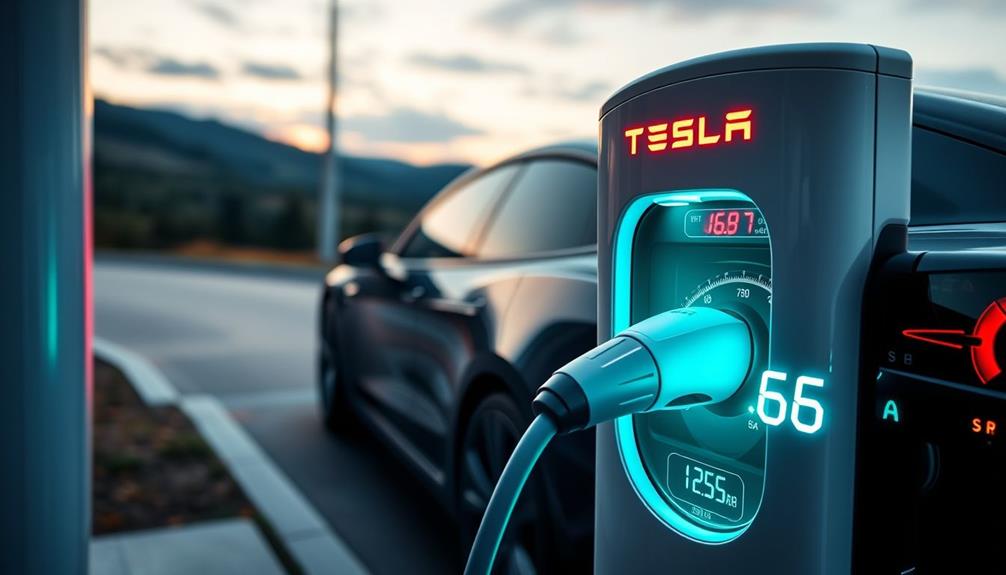
When you're on a long road trip, Tesla Superchargers can be a game changer, allowing you to quickly recharge your vehicle. With the ability to provide up to 200 miles of range in just 15 minutes, you'll greatly reduce your wait times. The charging speed varies based on your Tesla model and battery capacity, but V3 Superchargers deliver peak charge rates of up to 250 kW, making the charging process efficient.
However, it's essential to recognize that as your battery approaches full capacity, the charging speed decreases. This gradual reduction helps maintain battery health and longevity, ensuring your Tesla remains reliable over time.
Superchargers utilize DC fast charging, which is much quicker than standard AC charging methods typically used at home.
Efficiency rates can also fluctuate due to factors like your battery state, temperature, and station usage. These variables can lead to variations in charging times, so it's wise to plan your Supercharging sessions accordingly.
Idle and Congestion Fees
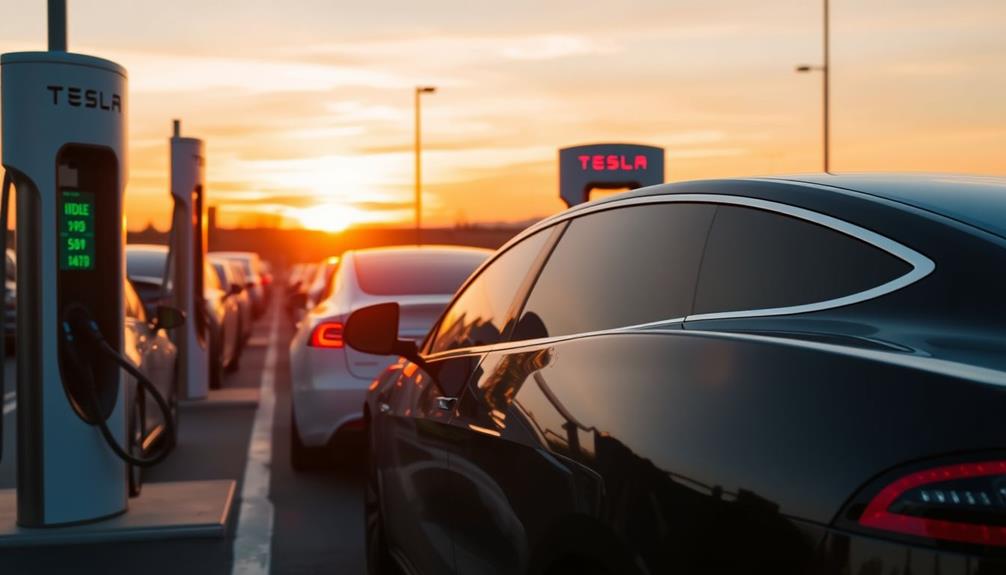
When you charge your Tesla, it's important to be aware of idle and congestion fees that can quickly add up.
If you stay connected after reaching a full charge, you might face charges ranging from $0.50 to $1.00 per minute, especially during peak times.
Understanding how these fees work can help you avoid unnecessary costs while using Supercharger stations.
Idle Fee Structure
Tesla's idle fee structure is designed to promote efficient use of Supercharger stations. When your vehicle reaches a full charge, you have a limited time to unplug before idle fees kick in. Here's how it works:
- $0.50 per minute for staying connected after a full charge.
- $1.00 per minute if the Supercharger station hits 100% capacity.
- Fees apply only when stations are 50% full or higher.
- Enjoy a five-minute grace period to disconnect before fees accrue.
- Stay informed about your charging costs through the Tesla app.
During peak hours, congestion fees can also apply, charging $1.00 per minute if your vehicle's battery is above 80% full.
This structure encourages you to unplug promptly, ensuring that all drivers have access to charging stations when they truly need them.
The Tesla app will notify you of any incurred idle and congestion fees, so you're always aware of your costs.
Congestion Charge Explanation
Efficient use of Supercharger stations is further supported by congestion charges that come into play during busy periods. When your vehicle's battery is above a certain level, you may face congestion fees if you remain plugged in while others are waiting.
Tesla's app will alert you when these fees might apply, giving you a five-minute grace period to disconnect before incurring any additional costs.
Idle fees, on the other hand, kick in if you stay connected to a Supercharger after reaching full charge. These fees can range from $0.50 to $1.00 per minute, depending on the station's capacity.
If the station hits full capacity, the idle fee doubles, stressing the importance of moving your vehicle promptly once charging is complete.
It's essential to note that both idle and congestion fees won't apply simultaneously. This means you'll only be charged for one type of fee at any given time.
Savings With Solar Charging
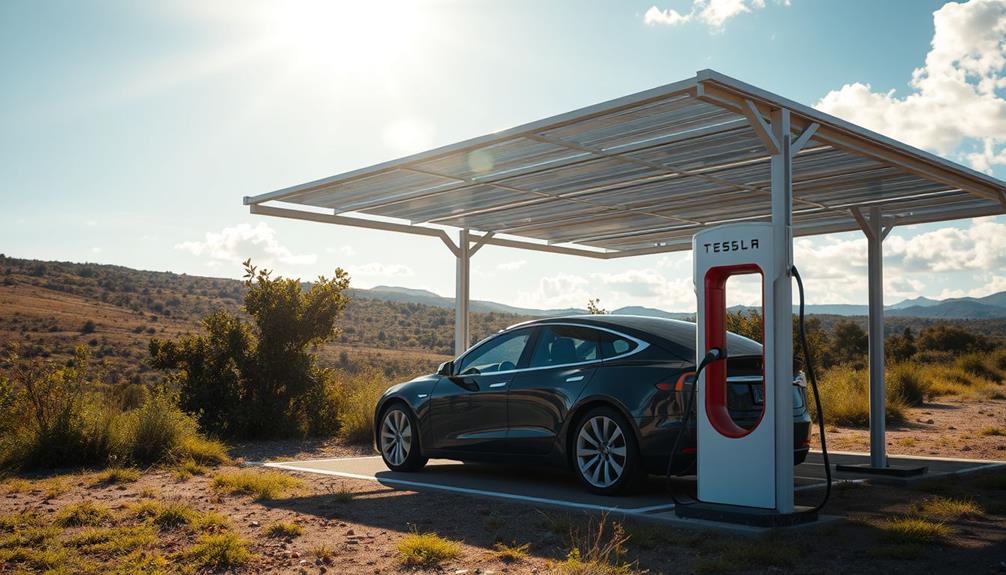
Switching to solar charging can lead to substantial savings for Tesla owners. By harnessing the power of the sun, you can greatly reduce your charging costs. The average cost for solar charging is around $0.06 per kWh, while Supercharging can run up to $0.25 per kWh. Over time, the savings add up!
Imagine:
- No more high Supercharging bills
- Free charging after your solar investment pays off
- An annual savings of about $1,500
- Reduced operational costs for your Tesla
- A sustainable energy solution for your home
With approximately five solar panels needed to cover the energy consumption of a Tesla Model 3, you'll be well on your way to maximizing your savings.
Once your home solar system is installed, you'll enjoy free charging after 7-8 years. Pairing a solar inverter with a home charging station is essential for efficiently utilizing solar energy, ensuring you get the most out of your investment.
Comparison to Gas Vehicles
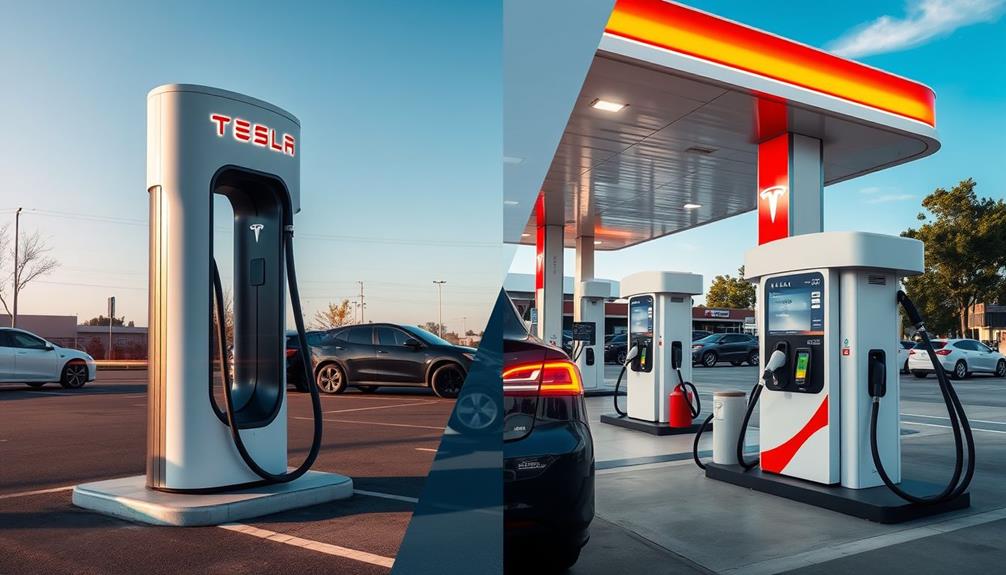
When considering the overall cost of vehicle ownership, electric vehicles like Teslas clearly outshine traditional gas vehicles. The cost to charge your Tesla at Supercharger stations averages between $6 to $50, depending on your model and charging rates. In contrast, fueling costs for gas vehicles can set you back about $1,850 annually. That's a significant difference!
When you break it down, Tesla owners pay roughly 4.56 cents per mile for electricity, while gas vehicles cost about 13.73 cents per mile. This translates to substantial savings over time. Over a lifetime of 300,000 miles, you could save up to $12,000 just in fueling costs alone.
Moreover, a Department of Energy study shows that electric vehicles operate at around 6.1 cents per mile, compared to 10.1 cents for gas vehicles. This highlights not only the savings but also the efficiency of electric vehicles.
Factors Influencing Charging Costs
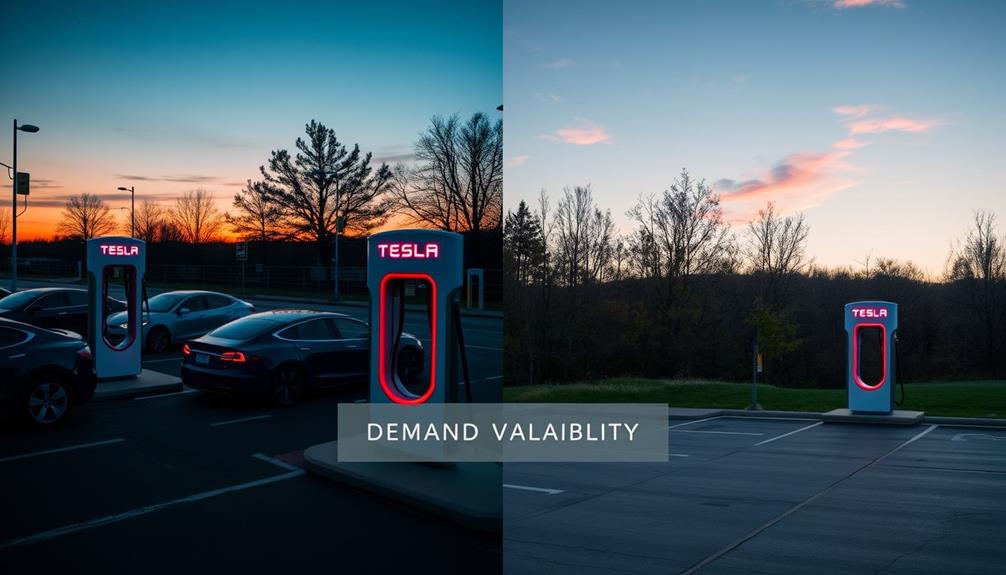
Charging costs at Tesla Supercharger stations can feel a bit like a rollercoaster ride, with various factors influencing what you'll pay. Understanding these elements can save you money and make your charging experience smoother.
- Location: Charging rates vary widely based on where you are, from urban centers to rural areas.
- Time of Day: Rates often shift during peak hours, so charging during off-peak times can be cheaper.
- Idle Fees: If you stay connected after reaching full charge, you could face idle fees ranging from $0.50 to $1.00.
- Congestion Fees: When Supercharger stations are busy, congestion fees apply, starting at $1.00 per minute if your battery's above a certain level.
- Energy Used to Charge: The efficiency of the charger impacts your total cost; Level 3 chargers are more efficient than Level 1 or Level 2.
For Tesla vehicle owners, knowing these factors influencing charging costs can help you better manage your expenses and maximize your charging experience.
Frequently Asked Questions
Is Fast Charging Free for Tesla?
Fast charging isn't free for you at Tesla Superchargers. You'll typically pay between $6 and $50 per charge, depending on your model and local rates. Be mindful of idle fees if you linger after charging.
How Much Does It Cost to Charge a Tesla on a Fast Charger?
Charging your Tesla at a Supercharger typically costs between $27 to $50 for a full charge. Rates depend on location and time, so you might find lower or higher prices than average during your visits. If you have a Tesla, supercharging can be a convenient and efficient way to charge your vehicle while on the go. The Tesla Supercharging network provides high-speed charging, allowing you to add up to 200 miles of range in as little as 15 minutes. While the cost of supercharging may be higher than charging at home, the convenience and speed of the process can make it a worthwhile option for road trips or times when you need a quick charge.
Can You Charge for Free at a Tesla Supercharger?
You can't charge for free at Tesla Superchargers most of the time. While occasional promotions might pop up, you should check your Tesla account regularly to stay updated on any potential free charging opportunities.
Is It Cheaper to Charge a Tesla at Home or Supercharger?
Isn't saving money great? Charging your Tesla at home usually costs less than using a Supercharger. Home charging averages about $16 to $18.50 for 250 miles, while Supercharging can run you $20 to $25.
Conclusion
In the end, understanding Tesla Supercharger costs is essential for planning your electric journey. While some charging options may be free, others come with fees that can add up. Remember, "a penny saved is a penny earned." By considering factors like charging speed, efficiency, and even solar options, you can maximize your savings and enjoy the ride. So, keep these insights in mind as you hit the road and charge up your Tesla with confidence!





